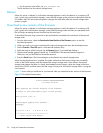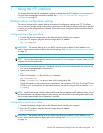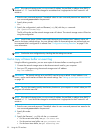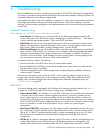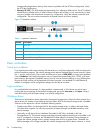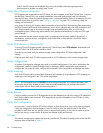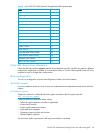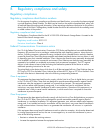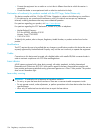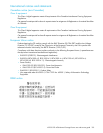
98 Troubleshooting
Even if the SCSI devices are displayed, they are not accessible unless the mapping mode is
auto-assigned or another non-empty map is used.
Verify Fibre Channel connection
If SCSI devices are recognized on the SCSI buses, but do not appear to the Fibre Channel host, it may be
that the Fibre Channel link is not properly established. Most hubs and switches have link indicators,
showing link status. When the network storage router is connected and the library is powered-on, this link
indicator should show a good link (see ”Operation indicators” on page 10). If it does not, check the
cabling and connections.
As a means of verifying link integrity when connected to a functional host, disconnecting then reconnecting
the Fibre Channel cable should cause momentary activity of this indicator as the link itself reinitializes. Also
verify that the media type of the network storage router and attached hub, HBA, or switch are of
corresponding types. When using optical media, verify that the attached device is using non-OFC type
optical devices.
Also, make sure that the network storage router is configured with the same speed as the device it is
connected to, and that the host is assigned to a LUN map filled with the devices it should be able to
communicate with.
Verify SCSI devices in Windows NT
If running FC-to-SCSI mapping mode, open the NT Control Panel, select SCSI Adapters, and double click
on the FC HBA. The SCSI devices should be listed.
If no devices are listed, verify the network storage router configuration, FC HBA configuration, and
cabling.
If devices are listed, verify FC HBA mapping mode or AL_PA addresses on the network storage router.
Verify configuration
A number of configuration changes may result in an invalid configuration. If you are in doubt about the
configuration, restore the network storage router to the factory default configuration and proceed to
configure the unit a step at a time, verifying the functionality of the configuration as changes are made.
Verify mapping
Verify that all desired devices have been discovered and mapped. If using Indexed or SCC mapping, try
swapping to Auto-assigned to see if this solves the problem.
NOTE: HP recommends that you DO NOT use Auto-Assigned long-term as it exposes the library and
drives to the entire SAN. Instead, a custom map should be created with only the hosts that need to
communicate with the library and the drives assigned to it.
Verify devices
It may be useful to connect the SCSI target devices you are attempting to use to the native SCSI interface to
verify that the devices are functional. SCSI target devices can be connected to a host SCSI bus to verify
they are functional.
Verify host configuration
In some cases, it may be that the FC host bus adapter or host device driver may not be working properly.
Check the configuration of these elements. It may be useful to check the release notes for the driver
provided to see if there are any specific issues or required configuration. It may also be useful to ensure
that you are using a current version of the host bus adapter driver and firmware.
PRLI data
The network storage router supports the discovery mechanism. The network storage router returns the PRLI
response data as specified in Table 8.



